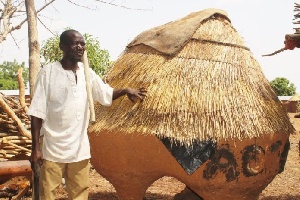 File photo: A farmer in the Northern region
File photo: A farmer in the Northern region
More effort is required to transform the northern parts of the country if Ghana is to achieve the Sustainable Development Goals (SDGs), a new United Nation’s Development Programme (UNDP) report on human development has said.
The Northern Ghana Human Development Report (NG-HDR), based on a study that investigated livelihood issues relating to health, education and infrastructure gaps, as well as governance and environmental issues, revealed that the northern zone has witnessed good development over the years.
However, it said for the country to realize especially SDG 1, which aims to eradicate poverty in all its forms everywhere, greater efforts have to be made to end poverty in the northern Ghana.
The report entitled “Bridging the Poverty Gap and Fostering Socio-Economic Transformation for All,” explores development challenges and opportunities in Northern Ghana and offers suggestions for poverty eradication in the zone.
To ensure inclusive growth, the report recommends the need for a coordinated stakeholder approach to address development gaps in road infrastructure; in information, communications and technology (ICT); education and healthcare delivery; youth unemployment; energy access; data gaps for development planning; gender inequity; as well as high climate change impact on agriculture and livelihoods.
It suggests massive investments in infrastructure development and recognizes the importance of complementing the Government’s “One Village One Dam Initiative” to boost agriculture production in the northern zone.
It also highlights how improvement in road and water transport networks; and investment in warehousing, cold chains, and processing infrastructure will help increase value additions and reduce post-harvest losses, to facilitate industrialization in the zone.
Moreover, the importance of resource mobilization and equitable allocation to help address the Human Development deficits in Northern Ghana to ensure that “No One Is Left Behind”, is emphasized by the report.
The report, therefore, calls for strong partnerships among stakeholders to leverage synergies and ensure that local people are empowered to benefit and to drive transformation in the zone.
To improve quality education and healthcare delivery, the Human Development Report recommends innovative Public-Private Partnerships to facilitate access to housing for health and education staff to attract and retain staff in the education and health sectors especially in rural communities in the northern zone.
In addition, the report identifies the promotion of conservation and climate change adaptation best practices including tree planting to reduce soil degradation and promote water conservation particularly along streams and waterways; encouraging local community seedbanks and nurseries; and scaling up agricultural extension services to support farmers.
The UNDP Ghana Country Director, Ms. Gita Honwana Welch, noted that the Northern Ghana Human Development Report, like other Human Development Reports produced by UNDP, provides baseline information on areas requiring development attention in the North.
“UNDP collaborated with the University for Development Studies (UDS), the University of Ghana and Northern Development Authority (then Savanah Accelerated Development Authority) to produce this report.”
Ms. Welch said the findings and recommendations from the report are to inform and shape policy decisions that will propel transformational development in the north.
UNDP Ghana has over the years, produced national, district and regional reports for the country. The first regional Human Development Report was for the Western Region on the theme “Managing Development Opportunities for a Secure Future.”
The Northern Ghana Human Development Report (HDR) is the second regional report developed by UNDP Ghana, but this is for the Northern Savannah Ecological Zone – Upper East, Upper West, Northern Region and some parts of the Brong Ahafo and the Volta regions.